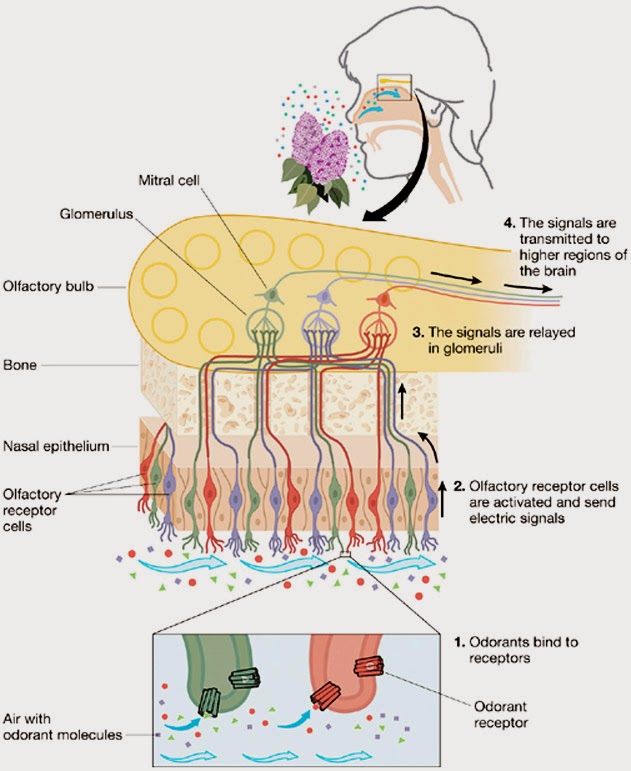It is a great pleasure to introduce a new contributor to
this blog! Jesse Hardy joins Azar and me on the Perfume Project Northwest team
as we continue to bring you a benignly eccentric mix of our free-ranging
thoughts, mostly about perfume. Jesse has written articles for Basenotes and
contributed many expert reviews to a number of other perfume websites where he
goes by the name LovingTheAlien. His first post here is a thoughtful
exploration of the ways in which language can express olfactory perceptions.
LANGUAGE AND OLFACTION
There is a pervasive belief in Western culture that smell is
of little importance. At worst, it is dismissed as a rudimentary relic of our
quadrupedal past; at best it is considered a subjective, indefinable sense.
From Plato to Kant, Western philosophy and literature have ranked olfaction
dead last in the list of important human senses. Aristotle believed that
individual scent elements could not be discretely identified, but merely
identified by association with corresponding emotions. More recent studies of
olfaction have revealed that scent, more than the other senses, is processed in
the limbic system – the “lower” region of the brain, responsible for much of
what constitutes our “id” – as well as the “higher” cortex. This finding has
only reinforced the idea that scent is an ancient, rudimentary sense,
inextricably tied to our past, when we (presumably) sniffed each others butts
and identified possible mates by smell.
Despite its primitive origins, or maybe because of them, our
olfactory capacity is laughable compared to that of our other mammalian
friends. Dogs have roughly 220 million olfactory receptor cells and well over
1000 olfactory receptor genes, while humans have only about 5 million receptor
cells and about 350 olfactory receptor genes. Nothing is more demonstrative of
our pitiful, devolved sense of smell than the common belief that we lack even
common language to describe our sense of smell – only that isn’t true.
Recent research into non-Western perceptual language has
demonstrated that several Southeast Asian languages have a repertoire of
abstract, non-referential words to describe odors. In these languages, scents
are identified as freely and with as much consensus as we can describe colors –
and this applies even to smells that have never been encountered before. The
Jahai dialect, for example, includes many basic, non-derivative terms for
odors. The direct ramifications are incredible: language can communicate odors
after all!
This should hardly come as a surprise to the particular
crowd that reads this blog. Many of us have spent years developing our ability
to identify and name specific odors in fragrance and, more importantly, have
participated in discussions of these characteristics. If there were no language
to communicate scent, how could one explain the existence of increasingly
numerous perfume forums and blogs where communication relies on words? Scent
can easily be communicated to people familiar with it, even to the extent of
the receiver being able to translate, more or less accurately, encoded scent
vocabulary into a mental “image” of the information. For instance, can you
imagine the scent of Fracas with vetiver? How about orange blossom and rubber?
The broader implications of specialized vocabulary dedicated
to describing odors are significant, particularly to the olfactorily inclined.
If our sociological understanding of olfaction is wrong in assuming that smells
cannot be named and communicated in the same way colors can, then how sturdy
are our physiological and philosophical understandings of scent? Is our
established understanding of olfaction a result of the WEIRD (Western,
Educated, Industrialized, Rich, and Democratic) phenomenon?
The reality is that statistical and empirical data on
olfaction are not overly-WEIRD, but are often construed in a frankly
unscientific manner to validate established beliefs. Olfaction is delegated to
the marginalia of scientific research and treated as a curiosity in the same
way that research on sexual behavior was in the 1940s. The Kinsey Report
challenged traditional beliefs about sexual behavior, but was old news for the
sexually liberated, and one can sense a strong resemblance in modern research
on olfaction. Perfumers and aroma chemical manufacturers have been using the
science of olfaction to develop products that are widely considered to be
novel, but our sense of smell and the research behind it are far from novel.
With any luck, the “discovery” of abstract olfactory language will pique the
interest of the scientific community and lend legitimacy to those researchers
willing to challenge traditional beliefs on olfaction, Until then, readers,
stay olfactorily liberated, and encourage others to do the same!
[Photo of Jesse (channeling Harry Potter?) courtesy of Jesse himself; olfactory receptor diagram from an educational website; other photos adapted from Wikimedia]















